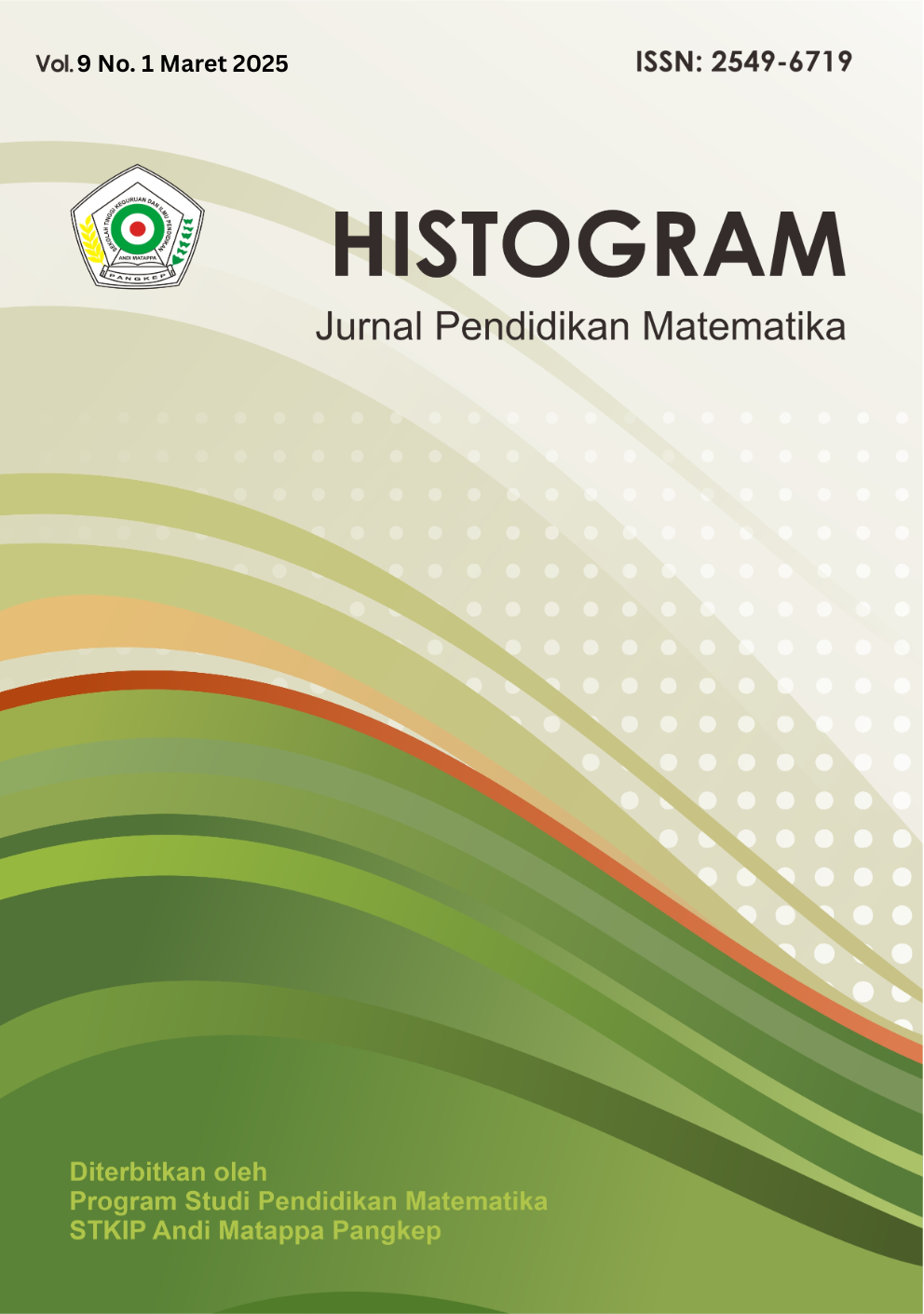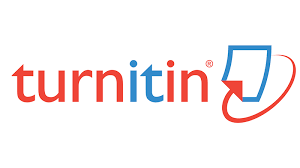DESAIN MEDIA PEMBELAJARAN FIND OUT GURUADIPA TERHADAP KEMAMPUAN BERPIKIR KRITIS BERBANTUAN APLIKASI SCRATCH
DOI:
https://doi.org/10.31100/histogram.v9i1.4218Keywords:
Media Pembelajaran, Game Edukasi, Kemampuan Berpikir KritisAbstract
ABSTRAK
Media pembelajaran mempermudah siswa memahami materi, namun minimnya inovasi membuat teknologi kurang dimanfaatkan dalam kelas. Penelitian ini bertujuan merancang game edukasi berbasis smartphone agar siswa bisa belajar sambil bermain. Penelitian ini menggunakan model pengembangan ADDIE dalam menciptakan media pembelajaran dengan berbantuan aplikasi pemrograman Scratch, media yang dikembangan berupa aplikasi Find Out GURUADIPA dengan materi Aritmatika Sosial. Hasil dalam penelitian media ini berupa desain dan validasi dari ahli media dan ahli materi dengan presentase 88,7% dan 88,3% yang masuk dalam kategori valid artinya media Find Out GURUADIPA memenuhi kriteria sebagai media yang valid dan layak digunakan dalam peningkatan kemampuan berpikir kritis melalui penyajian materi yang interaktif dan soal-soal pemecahan masalah yang berdasarkan indikator berpikir kritis. Diharapkan media pembelajaran yang telah didesain dapat diimplementasikan pada pembelajaran untuk mengetahui keefektifan media sebagai bahan penelitian lanjutan.
ABSTRACT
Learning media facilitates students’ understanding of the material; however, a lack of innovation has led to the underutilization of technology in the classroom. This study aimed to design a smartphone-based educational game that enables students to learn while playing. The research employed the ADDIE development model to create the learning media using the Scratch programming application, resulting in the development of the Find Out GURUADIPA application with Social Arithmetic content. The results included the design and validation of the media by media experts and material experts, which obtained scores of 88.7% and 88.3%, respectively, and were categorized as valid. These findings indicate that Find Out GURUADIPA meets the criteria for valid and feasible media for improving critical thinking skills through interactive materials and problem-solving questions based on critical thinking indicators. It is expected that this learning media can be implemented in classroom settings to evaluate its effectiveness in future studies.
References
Afifulloh, M., & Cahyanto, B. (2021). Analisis Kebutuhan Pengembangan Bahan Ajar Elektronik. 31–36. https://dx.doi.org/10.26737/jpdi.v6i2.2515
Damarjati, S. (2021). Pengembangan Game Edukasi Berbasis Android sebagai Media Pembelajaran Berorientasi pada Kemampuan Berpikir Kritis. 4(2). http://jurnal.umk.ac.id/index.php/anargya
Hidayat, F., Rahayu, C., Barat, K. B., Nizar, M., Coblong, K., & Bandung, K. (2021). Model ADDIE (Analisis, Design, Development, Implementation, and Evalution) dalam Pembelajaran. 28–37. https://doi.org/10.15575/jipai.v1i1.11042
Mariani, R., Marzal, J., & Zurweni. (2021). Pengembangan Media Mobile Learning dengan Pendekatan Saintifik Berbasis Keterampilan Berpikir Kritis Matematis Siswa Kelas XI Madrasah Aliyah. 05(03), 3295–3310. https://doi.org/10.31004/cendikia.v5i3.815
Marini, L., Hendriani, W., & Wulandari, P. Y. (2024). Gambaran Problematic Smartphone Use Pada Remaja. 5(1), 43–55. https://doi.org/10.24014/pib.v4i1.26477
Padmakrisya, M. R., & Meiliasari. (2023). Studi Literatur: Keterampilan Berpikir Kritis dalam Matematika. 7(6), 3702–3710. https://doi.org/10.31004/basicedu.v7i6.6327
Rahayu, P. Y. (2021). Uji Kelayakan Validasi Praktisi Buku Panduan Praktik Kewirausahaan Pada Mahasiswa Program Studi Pendidikan Ekonomi. X(X). http://openjournal.unpam.ac.id/index.php/Pekobis/index
Rismayanti, T. A., & Sukirwan, N. A. (2022). Pengembangan E-Modul Berbantu Kodular pada Smartphone untuk Meningkatkan Kemampuan Berpikir Kritis Matematis Siswa SMP. 06(01), 859–870. https://doi.org/10.31004/cendekia.v61.1286
Sariyanto, S., Suprayitno, I. J., & Sulistyaningsih, D. (2025a). Analisis Kebutuhan Media Edugame untuk Menunjang Pembelajaran di Era Digitalisasi pada Kelas VII. 4(4), 2052–2059. https:doi.org/10.56799/jceki.v4i4.9318
Sariyanto, S., Suprayitno, I. J., & Sulistyaningsih, D. (2025b). Effectiveness of Quizz-based Edugame as Learning Support Media for Improvement of Learning Outcomes. 5(1), 22–31. https://doi.org/10.58740/juwara.v5i.377
Sariyanto, S., Supriyitno, I. J., & Sulistyaningsih, D. (2025c). Digitalisasi Pembelajaran: Pengaruh Edugame terhadap Kemampuan Berfikir Kritis Siswa. 4(2), 712–718. https://doi.org/10.56799/jceki.v4i2.6572
Setiawan, H. R., Rakhmadi, A. J., & Raisal, A. Y. (2021). Pengembangan Media Ajar Lubang Hitam Menggunakan Model Pengembangan ADDIE. 4(2), 112–119. https://doi.org/10.31004/cendekia.v5i2.643
Siagian, T. A., Azalia, B., Rahmawati, R., Ferdaus, O. M., & Lestary, R. (2023). Pengembangan Media Pembelajaran Aritmatika Sosial Berbasis Android (BRUNETTA) pada Kelas VII SMPN 17 Kota Bengkulu. 7(1), 118–131. https://doi.org/10.33369/jp2ms.7.1.118-131
Surahmawan, A. N. I., Arumawati, D. Y., Palupi, L. R., Widyaningrum, R., & Cahyani, V. P. (2021). Penggunaan Media Wordwall sebagai Media Pembelajaran Sistem Pernafasan Manusia Ardis. 1, 95–105. http://ejournal.stkip-pgri-sumbar.ac.id/index.php/JRFES
Tajuddin, S., Anoegrajekti, N., Attas, S. G., & Rahman Bahtiar, I. (2023). Peningkatan Kompetensi Pembuatan Media Pembelajaran Berbasis Scratch bagi Guru-Guru Bahasa Indonesia Kabupaten Cianjur. BERNAS: Jurnal Pengabdian Kepada Masyarakat, 4(4), 2594–2599. https://doi.org/10.31949/jb.v4i4.6446
Vhalery, R., Pratikto, H., & Rahayu, W. P. (2024). Gamifikasi Pembelajaran Matematika Ekonomi. 10(1), 444–459. http://dx.doi.org/10.30998/rdje.v10i1.22843
Widiyatmoko, A., Utaminingsih, S., & Santoso. (2021). Android-Based Math Learning to Improve Critical Thinking. Journal of Physics: Conference Series, 1823(1), 6–13. https://doi.org/10.1088/1742-6596/1823/1/012091
Wira, A. (2021). Validitas dan Efektivitas Media Pembelajaran Berbasis Android Mata Pelajaran Komputer dan Jaringan Dasar. 1–10. https://doi.org/10.37859/jeits.v3i1.2602
Yolanda, L., Wang, C., Zhang, M., & Sesunan, A. (2023). Peran Teknologi dalam Transformasi Pendidikan di Indonesia. Oliver Wyman Forum.
Downloads
Published
Issue
Section
Citation Check
License
Copyright (c) 2025 Slamet, Iswahyudi Joko Suprayitno, Dwi Sulistyaningsih

This work is licensed under a Creative Commons Attribution-NonCommercial-NoDerivatives 4.0 International License.
Please find the rights and licenses in Histogram: Jurnal Pendidikan Matematika. By submitting the article/manuscript, the author(s) accept this policy.
1. License
The non-commercial use of the article will be governed by the Creative Commons Attribution license as currently displayed on Creative Commons Attribution-ShareAlike 4.0 International.
2. Author's Warranties
The author warrants that the article is original, written by a stated author(s), has not been published before, contains no unlawful statements, does not infringe the rights of others, is subject to copyright that is vested exclusively in the author and free of any third party rights, and that any necessary written permissions to quote from other sources have been obtained by the author(s).
3. User Rights
Histogram: Jurnal Pendidikan Matematika's spirit is to disseminate articles published for free. Under the Creative Commons license, Histogram: Jurnal Pendidikan Matematika permits users to copy, distribute, display, and perform the work for non-commercial purposes only. Users will also need to attribute authors and Histogram: Jurnal Pendidikan Matematika when distributing works in the journal.
4. Rights of Authors
Authors retain all their rights to the published works, such as (but not limited to) the following rights;
- Copyright and other proprietary rights relating to the article, such as patent rights,
- The right to use the substance of the article in one's future works, including lectures and books,
- The right to reproduce the article for one's purposes,
- The right to self-archive the article,
- The right to enter into separate, additional contractual arrangements for the non-exclusive distribution of the article's published version (e.g., post it to an institutional repository or publish it in a book), with an acknowledgment of its initial publication in this journal (Histogram: Jurnal Pendidikan Matematika).
5. Co-Authorship
If other authors jointly prepared the article, any author submitting the manuscript warrants that all co-authors have authorized them to agree on this copyright and license notice (agreement) on their behalf and agree to inform their co-authors of the terms of this policy. Histogram: Jurnal Pendidikan Matematika will not be held liable for anything arising from the author(s) internal dispute. Histogram: Jurnal Pendidikan Matematika will only communicate with the corresponding author.
6. Royalties
This agreement entitles the author to no royalties or other fees. To such an extent that it is legally permissible, the author waives their right to collect royalties relative to the article regarding any use by Histogram: Jurnal Pendidikan Matematika.
7. Miscellaneous
Histogram: Jurnal Pendidikan Matematika will publish the article (or have it published) in the journal if the editorial process is completed. Histogram: Jurnal Pendidikan Matematika h editors may modify the article to a style of punctuation, spelling, capitalization, referencing, and usage that deems appropriate. The author acknowledges that the article may be published to be publicly accessible, and such access will be free of charge for the readers, as mentioned in point 3.





